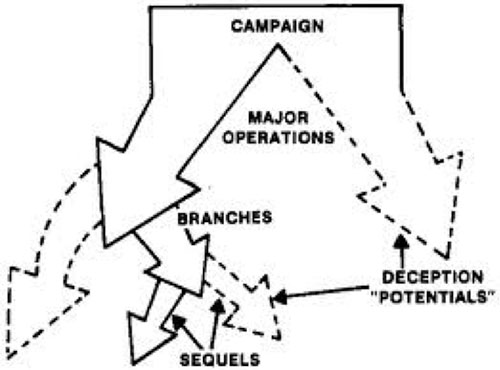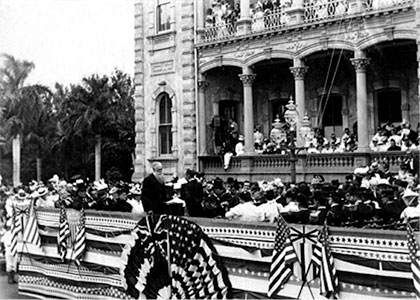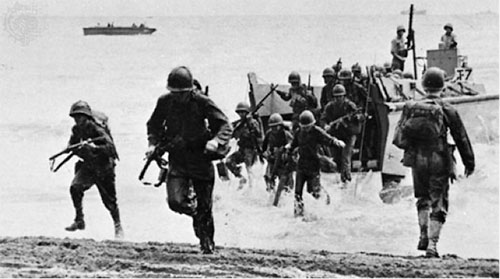Branches and Sequels
Editor’s Note: We are off to an interesting week in Your Nation’s Capital. I am going to have to make a trip to the Commissary to stock up on popcorn. My favorite moment in the flurry of “They lie!” moments on the daily news cycle was the entertaining image of the distinguished Senate Minority Leader arguing with Senator Tom Cotton about how things were eight years ago as another Administration was pulling itself together, and whether this iteration of change is going as smoothly as others. The particular bone of contention was the cofirmation of the nominee for Director of the CIA, former Kansas Congressman Mike Pompeo. Cotton apparently considered the matter (resolved with confirmation last night) as vital to the national security. He was irate that Schumer was delaying a floor vote on the nomination. When Cotton objected, Schumer retorted that the Senate had never confirmed a CIA director on Inauguration Day, adding that Senate Republicans did not do the same for former President Barack Obama. He continued that Cotton would have known this if he had been in the Senate eight years ago.
As a member of the 101st Airborne Division with two deployments to the CENTCOM AOR, Cotton knew exactly where he was: ““Eight years ago, I was getting my ass shot at in Afghanistan. So, don’t talk to me about where I was.”
This defiintely a breach of the Upper Chamber’s famous decorum and frayed collegiality, but now that we have entered the land of the Media Narrative, the post-factual landscape and the bewildering terrain of alternate truth, this is going to be entertaining. Even more entertaining is the idea that the Director of the CIA is much more urgent for confirmation than the Director of National Intelligence, former Senator Coats. We know where he was then- right there in the Senate with Mr. Schumer.
– Vic
Branches and Sequels

(Military Doctrine of “Shit Happens” from Joint Pub 1).
Preparations for offensive operations against Japan had been in place since the pre-conflict days of Plan Orange; there is nothing our military has learned how to do better than plan. Mac was part of all that, of course, and I have a couple of stories that Jasper Holmes used to tell about him.
The mission was spilling out of the Dungeon at Building One at the Pearl Harbor Shipyard and was changing as the requirements to support offensive amphibious operations in the Southwest Pacific emerged. It was in The Plan.
Six weeks after the Battle of Midway, the Intelligence Center Pacific (ICPOA) was established with CDR Joe Rochefort temporarily double-hatted as Officer in charge of of both ICPOA and the operationally subordinate Station HYPO.
The first US doctrine of expeditionary warfare came with the development of War Plan Orange in 1890, long before the little war that stripped Spain of its possessions in the Caribbean and Pacific, and catapulted America into the ranks of the Colonial powers in 1898.

(Annexation Ceremony at the Iolani Palace, Honolulu, 1898).
Theodore Roosevelt modified War Plan Orange as a contingency for conflict with Japan. The annexation of Hawaii in 1898 relieved the immediate tension with the burgeoning Meiji empire, but the Navy and War Departments continued to plan.
Generally speaking, the Plan was inviolate, and was based on enduring principles and assumptions from the Spanish War that were a half-century old.
As rising senior officers in the joint schoolhouse, my generation was taught to deal with reality the Army way, with the going in assumption that “no plan survives first contact with the enemy,” which is military-speak for the civilian doctrine that “shit happens.”
To deal with an altered landscape after that first contact, alternative scenarios were always considered. We were taught to call these “Branches and Sequels” as consequences flowed downstream from events.
There were other plans, of course, a whole rainbow of colors. PLAN RED was the Atlantic Strategic War Plan, which originally was oriented against Great Britain, if you can imagine, though branches and sequels in 1914 resulted in the substitution of Germany for the UK. The First War branches and sequels created the RED-ORANGE PLAN, which hypothesized a two-theater war with initial emphasis on operations in the Atlantic.

(Edward Miller’s War Plan Orange history)
War Plan Orange, which came in Navy and Army flavors, consisted three phases, adapted as new technology changed military capability being introduced to the Army and Navy. Plan Orange envisioned:
Phase I: The U.S. expected the loss of the lightly defended outposts south and west of Japan, which could not be defended. The Plan assumed the Navy would concentrate the Fleet at their homeports in order to surge forward.
Phase II: With superior naval and air power, the Navy and Marines would advance west. Small-scale attacks against Japanese occupied islands would capture them and establish supply routes and overseas basing for new long-range bombers like the B-29.
Phase III: The U.S. would then advance toward Japan utilizing islands that were parallel to and near Asia. These newly acquired bases could choke Japanese trade and allow air bombardment of Japanese cities and industry, leading to victory without invasion of the Japanese homeland.
The complex nature of the plan required close cooperation between the Army and Navy, and Army-Navy Board (better known as the Joint Board) was created in 1903 to de-conflict the efforts of two independent cabinet Departments.
We talked about Richmond Kelly Turner, whose high-handed and arrogant conduct as Chief of Navy War Plans (OP-16) was not limited to abusing the Office of Naval Intelligence. His contempt for the Army was so profound that George Marshall demanded he be removed from his position.
CNO “Betty” Stark had no stomach for a fight with Marshall, and despite Turner’s success in devising a Rainbow palette of options based on Stark’s “Plan Dog” memo of 1940. While he might have been indecisive, Stark was intelligent and subtle. He anticipated an expected two front war against Germany and Italy in Europe and Japan in the Pacific, with Europe the first priority.
Turner was dispatched to cool his heels as a Deputy Chief of Staff under leathery Admiral Ernie King as the newly-created Commander in Chief US Fleet for six months.
Phase II of the plan provided a combat job for Turner as Commander of Amphibious Forces Southwest pacific that could harness his truculent intelligence into something useful.
The Branches and Sequels created by the code-breakers who enabled the victory at Midway let Phase II of Plan Orange go forward. The plans existed for operations in the Solomons, and the Marines landed on Guadalcanal.

(Marines land at Guadalcanal, August, 1942).
Phase II required Eddie and Joe and Jasper and Mac to adapt to new Branches and Sequels, and that meant that the nature of intelligence support to the war had to change.
Part of going on the offensive was using the radio intelligence to interdict and foil Japanese operations while not disclosing the sensitive nature our of sources and methods. Which is how Eddie Layton came up with a novel plan to kill his old bridge partner, Admiral Isoroku Yamamoto. That is quite a story in its own right, but as they say, fortune favors the bold, right?
Copyright 2010 Vic Socotra
www.vicsocotra.com
